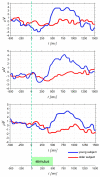Assessment and Scientific Progresses in the Analysis of Olfactory Evoked Potentials
- PMID: 35735495
- PMCID: PMC9219708
- DOI: 10.3390/bioengineering9060252
Assessment and Scientific Progresses in the Analysis of Olfactory Evoked Potentials
Abstract
The human sense of smell is important for many vital functions, but with the current state of the art, there is a lack of objective and non-invasive methods for smell disorder diagnostics. In recent years, increasing attention is being paid to olfactory event-related potentials (OERPs) of the brain, as a viable tool for the objective assessment of olfactory dysfunctions. The aim of this review is to describe the main features of OERPs signals, the most widely used recording and processing techniques, and the scientific progress and relevance in the use of OERPs in many important application fields. In particular, the innovative role of OERPs is exploited in olfactory disorders that can influence emotions and personality or can be potential indicators of the onset or progression of neurological disorders. For all these reasons, this review presents and analyzes the latest scientific results and future challenges in the use of OERPs signals as an attractive solution for the objective monitoring technique of olfactory disorders.
Keywords: ERPs; OERPs; anosmia; brain; electroencephalography; grand averaging; hyposmia; olfactory dysfunction; olfactory evoked potentials; smell.
Conflict of interest statement
The authors declare no conflict of interest.
Figures







Similar articles
-
Olfactory event-related potentials (OERPs) and trigeminal event-related potentials (TERPs) - a pilot study in Czech participants with normal sense of smell.J Appl Biomed. 2023 Dec;21(4):167-173. doi: 10.32725/jab.2023.020. Epub 2023 Dec 7. J Appl Biomed. 2023. PMID: 38112455
-
Olfactory event-related potentials (OERPs) and trigeminal event-related potentials (TERPs) in subjects after Covid-19 infection: single-center prospective study.J Appl Biomed. 2024 Sep;22(3):149-154. doi: 10.32725/jab.2024.020. Epub 2024 Sep 23. J Appl Biomed. 2024. PMID: 39434512
-
[Development and application of gustatory evoked potentiometer].Lin Chuang Er Bi Yan Hou Tou Jing Wai Ke Za Zhi. 2025 Mar;39(3):276-280. doi: 10.13201/j.issn.2096-7993.2025.03.018. Lin Chuang Er Bi Yan Hou Tou Jing Wai Ke Za Zhi. 2025. PMID: 40049648 Review. Chinese.
-
Measurement and Analyses of Olfactory Event-Related Potentials.Methods Mol Biol. 2025;2915:117-129. doi: 10.1007/978-1-0716-4466-9_6. Methods Mol Biol. 2025. PMID: 40249486
-
Pearl and pitfalls in brain functional analysis by event-related potentials: a narrative review by the Italian Psychophysiology and Cognitive Neuroscience Society on methodological limits and clinical reliability-part II.Neurol Sci. 2020 Dec;41(12):3503-3515. doi: 10.1007/s10072-020-04527-x. Epub 2020 Jul 18. Neurol Sci. 2020. PMID: 32683566 Review.
Cited by
-
Olfactory neurofeedback: current state and possibilities for further development.Front Hum Neurosci. 2024 Nov 29;18:1419552. doi: 10.3389/fnhum.2024.1419552. eCollection 2024. Front Hum Neurosci. 2024. PMID: 39677402 Free PMC article.
-
Uncovering the Correlation between COVID-19 and Neurodegenerative Processes: Toward a New Approach Based on EEG Entropic Analysis.Bioengineering (Basel). 2023 Mar 29;10(4):435. doi: 10.3390/bioengineering10040435. Bioengineering (Basel). 2023. PMID: 37106622 Free PMC article.
-
An experimental paradigm for studying EEG correlates of olfactory discrimination.Front Hum Neurosci. 2023 May 25;17:1117801. doi: 10.3389/fnhum.2023.1117801. eCollection 2023. Front Hum Neurosci. 2023. PMID: 37305363 Free PMC article.
-
Unpleasant odors compared to pleasant ones cause higher cortical activations detectable by fNIRS and observable mostly in females.APL Bioeng. 2025 Jan 7;9(1):016101. doi: 10.1063/5.0231217. eCollection 2025 Mar. APL Bioeng. 2025. PMID: 39801499 Free PMC article.
-
Olfactory event-related potentials (OERPs) and trigeminal event-related potentials (TERPs) - a pilot study in Czech participants with normal sense of smell.J Appl Biomed. 2023 Dec;21(4):167-173. doi: 10.32725/jab.2023.020. Epub 2023 Dec 7. J Appl Biomed. 2023. PMID: 38112455
References
-
- Raudenbush B., Grayhem R., Sears T., Wilson I. Effects of peppermint and cinnamon odor administration on simulated driving alertness, mood and workload. N. Am. J. Psychol. 2009;11:245–256.
-
- Promoting Social Interaction through Emotional Body Odours, 2019–2024. [(accessed on 20 May 2022)]. Available online: https://potionh2020.com/
Publication types
LinkOut - more resources
Full Text Sources

